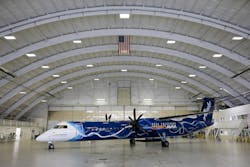ZeroAvia to retrofit Alaska Airlines regional turboprop to hydrogen
EVERETT, Wash., - Alaska Airlines in Seattle announced that the company was donating a retired Q400 turboprop regional aircraft to ZerioAvia in Hollister, Calif., with the intention of helping research and development efforts in retrofitting zero emissions technology in aviation.
ZeroAvia's hydrogen-electric engine uses fuel cells to generate electricity from hydrogen fuel, before using that electricity to power electric motors which turn the aircraft propellers. The certifiable ZA2000 system will include ZeroAvia's High Temperature PEM fuel cells and liquid hydrogen fuel storage, integral to delivering the necessary energy density for commercial operations of large regional turboprops. The company has already established an engineering partnership with De Havilland of Toronto, the original manufacturer of the Dash 8 family of aircraft to enable exchange of data and expertise with the airframe.
In January, ZeroAvia flew a retrofitted 19-seat aircraft with its prototype 600kW hydrogen-electric engine (ZA600). This followed the demonstration flight of a 250kW system in 2020, which at the time of flight was the world's largest aircraft flown using a novel zero-emission power source.
At an event, held at ZeroAvia's Paine Field research and development site near Seattle, the companies were joined by high school students from Raisbeck Aviation High School, Washington State Governor Jay Inslee, Congresswoman Suzan DelBene and Snohomish County Executive Dave Somers to participate in the formal handover of the 76-seat Q400 aircraft that will be developed by ZeroAvia, the U.S.-headquartered leader in designing and building zero-emission, hydrogen-electric aircraft propulsion systems for aircraft.
ZeroAvia also debuted its multi-megawatt modular electric motor system in a 1.8MW prototype configuration at the event - demonstrated with a propeller spin aboard the ZeroAvia's 15-ton HyperTruck ground-test rig.
The 1.8MW motor configuration demonstrated consists of two "HyperCore" motor modules, each a high-power, high-speed 900kW permanent magnet radial flux machine which operates at 20,000 rpm, matching the typical turbine engine power turbine speeds, providing an unprecedented 15kW/kg motor power density. Crucially, HyperCore's modular design enables the technology to address applications ranging from 900kW up to 5.4MW, meeting a number of regional turbo-prop and regional jet requirements. The HyperCores were successfully integrated with the stock Dash 8-400 engine gearbox and propeller.
The development and testing program will enable the understanding and measurement of system dynamics, calibration of physical and electrical models, and validation of thermal management systems. The company is concurrently developing world-class silicone-carbide power electronics and the matching hydrogen fuel cell systems, which convert hydrogen to electricity, powering the electric propulsion system. These systems will be brought together to create the full hydrogen-electric propulsion system, tested on the ground and then in the air.
